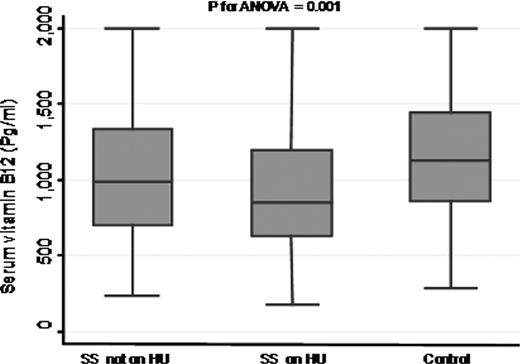Abstract
Abstract 1647
Clinical B12 (cobalamin) deficiency occurs in sickle cell disease (SCD) but it is uncommon (NEJM 2003;348:2204). Several publications report lower serum B12 concentrations in SCD subjects than in controls (Acta Haematol 1984;71:299; J Intern Med 1995;237:551; J Nat Med Assoc 2006;98:352). However, other studies do not show these differences (Am J Hematol 2004;76:114; South Med J 2004;97:149; J Am Coll Nutr 2000;19:608). Serum transcobalamin concentrations are high in SCD (Scand J Haematol 1983;30:135; Acat Haematol 1989;81:117) so that one would expect higher than normal B12 levels in these patients. We measured serum B12 concentrations in 467 children and adolescents with SCD and in 69 control subjects matched for age, sex, and ethnicity. All subjects were enrolled in the PUSH protocol, a multicenter study for determining the prevalence and significance of pulmonary hypertension in children with SCD. The median serum B12 concentration in SCD was lower than in controls (960 vs. 1094 pg/ml, p=0.003). No patient had a serum B12 value lower than 227 pg/ml (3 SD below the mean of control subjects) and sickle genotype did not affect B12 concentration. Univariate analysis in children with the Hb SS genotype (N=343) showed that age, body mass index, serum creatinine (all three p=0.0001), and red cell MCV (p=0.025) were each inversely correlated with B12 levels, and this suggested the possibility that as children grow, their B12 requirements increase. In SS children higher leukocyte counts, serum AST, and serum ALT were all associated with higher B12 levels (p=0.005, p=0.0001, and 0.011, respectively), while blood Hb concentration, a-thalassemia status, Hb F %, platelet count, and hemolytic parameters were unrelated to serum B12. The median B12 level in SS children (941 pg/ml) remained significantly lower than that of controls even after adjustment for age and WBC. Children with Hb SS who were taking hydroxyurea had significantly lower median B12 levels (845 pg/ml, N=141) than SS children not on this drug (992 pg/ml, N=200 p=0.027) (Figure) but after adjustment for age and WBC this difference was no longer significant (p=0.5).
These results suggest that (a) children with SCD have lower, though still normal, serum B12 concentrations than healthy subjects, (b) this difference is not explained by SCD leukocytosis so that it could represent increased B12 requirements, and (c) hydroxyurea treatment reduces B12 levels even further probably as a result of its lowering effect on leukocyte count. However, because hydroxyurea was not given in a randomized manner, we cannot exclude the confounding effect of age on B12 level in hydroxurea treated subjects. Since we and others (Acat Haematol 1989;81:117) show that in SCD serum B12 decreases with age, as is the case also in non-SCD individuals (Am J Clin Nutr 1997;66:741), it would seem prudent to monitor cobalamin levels in SCD adults, particularly in older subjects and in those taking hydroxyurea.
No relevant conflicts of interest to declare.
Author notes
Asterisk with author names denotes non-ASH members.


This feature is available to Subscribers Only
Sign In or Create an Account Close Modal